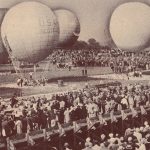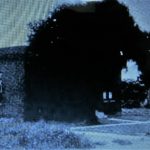by Eric Thompson (1905-1985):
In February, 1891, construction was begun on the New York – Chicago line west of Pittsburgh. This circuit was completed in December of that year into Cuyahoga Falls, 20 wires being strung at that time. A.S. Campbell of New York was superintendent of construction and E.J. Fullroad was foreman of the gang.
Many were the hardships experienced by these linemen, the working conditions in those days being decidedly different from those at the present time. But as they were all young, robust, full of ambition and pep, the weather and impassable roads never interfered with work.
At times it was so cold it was a question of how they could endure it. Perhaps the remark made by an old Irish woman who looked after the welfare of the lineman will explain it. She was often heard to say, “Sure, thim linemen can’t git cold, they have as miny coats on as an onion.”
The first conversation to New York from Cuyahoga Falls was with Mr. Watson of the New York office James Doyle making the test of the service. Miss Laura Hall also talked to Mr. Watson.
At first the work of the office was mainly testing and switching. Later it was a relay office and at one time all toll business originating at Akron was completed in the Cuyahoga Falls office.
Employment in those early days meant long hours, no holidays off and work under difficulties. Miss Hall was on the job for 10 years without a vacation, working on the average of 10 hours a day, including Sundays and holidays. Often after she left the board, Miss Hall went out collecting bills, soliciting for new subscribers or doing repair work.
Boys were employed as night operators until 1910 at which time the practice was discontinued and Maud E. Huren became night operator.
In 1922 a new building was built at Second and Portage Street and it was decided that with the installation of repeater and testboard equipment the operating at Cuyahoga Falls would be discontinued and the station would be used only as a repeater and test station. The new office was occupied on December 1922.
Cuyahoga Falls enjoys the distinction of being one of the most important centers of the Ohio Bell Telephone systems today.
The American Telephone and Telegraph Company established a long distance center here in 1922 and cables, which form a part of the national network, pass through “repeaters” here. When the voice energy has decreased to a very small amount, the repeater equipment picks it up and amplifies it to its original strength and passes it along.
This system, compared with the various stages through which the development of telephony has passed, is indicative of progress. Devices such as the turning of a crank to signal the operator are almost forgotten, yet at one time these antiquated magneto systems were regarded as the last word. These systems still exist, however, in some rural sections where it is impractical to install the more modern type of equipment which is designed for larger population centers.
Long distance telephone service which was only a dream was demonstrated to the public at the Columbian World’s Fair in 1893 in Chicago. Telephone lines were first used from city to city in 1896 to transmit election results when McKinley was elected president of the United States.
Other Telephone Posts
https://cuyahogafallshistory.com/tag/telephone/


